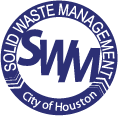I hope this expands in the near future.
The city launched a composting pilot program Wednesday, opening three sites where residents can drop off compost-friendly waste that otherwise would wind up in a landfill.
The hope is the program will help educate Houstonians on how to divert some of their trash away from the city’s rapidly filling landfills, which also can cut down on methane emissions.
“Very few people in Houston compost. This is a way to educate people about the benefits of it,” said At-Large Councilmember Sallie Alcorn, who led the effort to start a pilot program. “I know we’re not going to revolutionize the whole city by composting today, but it’s planting a seed, it’s educating people.”
Residents will be able to drop off their compost materials at three sites over the next six weeks: The Kashmere Multi-Service Center, from 9 a.m. to 11 a.m. on Saturdays; the Historic Heights Fire Station, from 5 p.m. to 7 p.m. on Wednesdays; and the Houston Botanic Garden, from 9 a.m. to 11 a.m. on Saturdays.
The city and its partners, Zero Waste Houston and Moonshot Compost, will take the materials to Nature’s Way, an organization that will turn the compost into soil over the course of 15 to 18 months.
[…]
Food materials sitting in landfills mark the third-largest source of human methane emissions in the United States, accounting for 14.1 percent of the emissions in 2017, according to the U.S. Environmental Protection Agency. The agency reported that methane emissions from municipal landfills in 2019 were equivalent to more than 21.6 million passenger vehicles driven for one year.
The region’s landfills also are quickly filling. A master plan for the Solid Waste department reported there is only about 30 to 40 years of capacity remaining at the city’s 12 landfills. Seven of them would be forced to close by 2040 unless they undergo major expansions. All private construction and demolition landfills are expected to reach capacity in that time, as well. The master plan called for increasing diversion programs, such as composting, to ease the burden on those sites.
I hope we can all agree that creating more landfill space is not the highest and best use of any existing property. Diverting some amount of waste that has other good uses away from the landfill is a great way to kick that can a good distance down the road. Recycling is a big part of that, composting is just taking it to the next level. Some places already have curbside compost pickup, and our goal should be to get there as well.
Compost-friendly materials include food scraps, such as coffee grounds and tea bags; meat and bones; moldy or freezer-burned food; fruits and vegetable; dairy; and seafood and shells. Alcorn reminded residents to remove paper stickers and other materials from the items before dropping them at the collection sites.
Acceptable materials also include compostable utensils, bags and cups; newspapers, fur, hair and nail clippings; flowers; paper napkins and towels; vegetarian pet bedding; and wood ash.
We do some backyard composting – my wife loves to garden, so she makes heavy use of what we compost – but not everything listed here goes into our bin. I need to make a plan to separate out some of that material and bring it to the Heights Fire Station next Wednesday.


7 days and counting……
Good luck getting people to drop off compost. I’m sure every neighborhood will have one treehugger in compliance and not many more than that.
Austin has door to door pickup, and if the lack of green bins at the curb every Friday in my (very liberal) neighborhood is any indication, even that isn’t very widely used.
San Francisco has long had a law requiring every household participate in their door to door compost program. That seems to work very well. Turns out people pretty much won’t do uncomfortable stuff voluntarily, but government mandates work. Whodathunk?